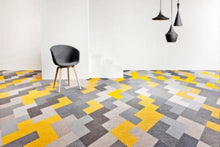Marmoleum/Linoleum Flooring
- Regular price
- $0.00
- Sale price
- $0.00
- Regular price
-
- Unit price
- /per
Adding product to your cart
Innovative Marmoleum flooring is made from a blend organic ingredients which are pressed together to produce sheets, tiles or planks. Wood flour, jute, rosin and linseed oil are the naturally occurring ingredients which make Marmoleum flooring an environmentally friendly flooring option. Marmoleum is low-maintenance and has natural antibacterial properties making it a perfect option for kitchens, bathrooms, schools and hospitals. Another truly great feature of this product is that the colours and designs are customizable. Innovative Marmoleum flooring is installed as a floating stylem, the tiles or panels simply click together. This installation process means Marmoleum can go over any pre existing sub floor. Innovative Marmoleum flooring is renewable, made from natural ingredients and easy to keep clean. Tony’s Flooring Centre is proud to carry an assortment of marmoleum flooring in a wide variety of colours and textures.

Which type of Marmoleum is best for your project?
Marmoleum can be used in almost every room of a home or office, depending upon the subfloor, who will install it and what colors you like.
How is it made?
- All natural ingredients:
- linseed and or tall oil
- limestone
- tree rosin
- wood flour
- natural mineral pigments
- jute
- USDA-certified bio-based product
- SMART-certified
- Allergy and Asthma Friendly
- Pre-sealed with Topshield2
- Warranted for 25 years residential and 5 years commercial
- Has the lowest environmental footprint of any flooring
- Carries the most independent Life Cycle Assessment (LCA)-based environmental labels and certifications
- Offers a dynamic color palette that makes it a leader in color and design
- Provides a 100+ year track record of performance and durability
- Sets a benchmark unmatched in the flooring industry
Which Marmoleum is best for you?
Five important questions to answer:
- What type of subfloor do you have?
- Will the installation be in new construction or a remodel?
- What is your budget?
- What type of foot/paw traffic will there be?
- What color(s) do you like?
1) Subfloor: concrete or wood?
Subfloors are usually made of concrete or wood (plywood, OSB, chipboard). Proper installation requires that the subfloor be clean, dry, flat, smooth and free of dips and bumps. Cracks and sloping subfloors need to be filled and leveled; this can be costly, as it usually requires professional installation. A plywood underlayment may also be needed on top of the subfloor.
2) Installation: new construction or remodel?
In older homes, click panels and squares are preferred because they're easier and faster to install than sheet or tile, and they require much less floor preparation. If you install the flooring directly over another floor such as vinyl, ceramic or hardwood, you can save time and money because there's no tear out required. This is possible with Marmoleum click because it requires no glue or nails, and it floats over the existing flooring or subflooring.
Proper vapor barriers are required such as Moisture Block; however, old sheet vinyl can act as a vapor barrier.
Installation of Marmoleum sheet or tile in an older home requires complete removal of the existing floor and usually some adjustment to the subfloor, as it has often settled or warped over time. Although the initial cost of the material may be less expensive than the click product, the preparation and installation costs could be far more.
In new construction, any of the three products can be used as there's usually little or no prep work required. For DIY installations, the click products are the easiest, but Marmoleum tile can be a good option because it's easy to install piece-by-piece and there's little waste. They are certainly easier to install than the sheet goods.
3) Budget-initial costs and long term costs
When you look at the costs of Marmoleum plus installation and maintenance, it can be less than cork, bamboo, hardwood and ceramic or vinyl tile. But, it all depends upon how much prep has to be done and who will do the installation and maintenance.
Bear in mind, preparation costs can be substantial for sheet and tile because the subfloor needs to be perfectly flat. This is true of any nail down hardwood floor, ceramic tile or vinyl tile floor too. However, the click product is much easier and requires little or no floor prep. Many customers have found installation of click panels or squares over existing subfloors by themselves can save a great deal of money.
However, if your subfloor is smooth and flat, and the dimensions of the room requires no seams, i.e. less than 79" wide, you can install Marmoleum sheet or tile by yourself. On the other hand, if you live in an older home that has severe settling and needs serious attention, you probably will need a professional no matter what type of floor you purchase.
4) Foot/Paw traffic
For those of you with dogs, cats or children, it's important to know that Marmoleum flooring, whether sheet, tile or click, will wear well. That's because it's a solid through-body product. Forbo does not claim that it will never be scratched, because it certainly can. But, it can be easily and inexpensively repaired and re-sealed creating a long-lasting finish unlike vinyl, laminate or ceramic tile, which can be scratched or cracked and not easily repaired.
Some of the largest users of Marmoleum are schools and hospitals. The primary reason is because it holds up to heavy foot and wheelchair traffic of all types, is colorful, completely non-toxic, anti-microbial, anti-static and repairable.
Marmoleum has proven that it can handle moisture very well. Recently divers explored relics for the 100-year anniversary of the Titanic and discovered lots of Marmoleum flooring that was still intact in the cabins after being underwater for 100 years! You read that right.
It has also proven that minor or major scratches can be buffed out with the right equipment. Making quick and easy repairs is far less expensive, time consuming and sustainable than sanding and refinishing the entire floor. Please see the Marmoleum maintenance guide for more details.
- Choosing a selection results in a full page refresh.
- Press the space key then arrow keys to make a selection.






